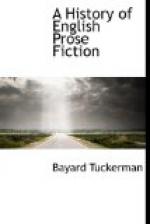Now let us apply the same test to romance. We open the “Morte d’Arthur”; we find ourselves at once in an unreal, almost nameless land; we meet with knights whom we only know apart by their armor, and queens ambling through pathless forests on white palfreys; we attend brilliant tournaments and witness superhuman deeds of arms. Our minds, untroubled by scepticism and thoughtless of unreality, yield themselves to the poetical illusion. Who stops to think of the incredible when Sir Bedivere hurls into the lake the dying Arthur’s sword Excalibur?
Then Sir Bedivere departed, and went to the sword, and lightly took it up, and went to the water side, and there he bound the girdle about the hilts, and then he threw the sword as far into the water as he might, and there came an arm and an hand above the water, and met it, and caught it, and so shook it thrice and brandished, and then vanished away the hand with the sword in the water.
But when we are introduced to the castle of Otranto, when we know its dimensions and appearance, when we have become acquainted with its inmates, and have been made to realize that they are flesh and blood like ourselves, we cannot receive without a shock the account of the supernatural occurrences by which they are affected. It is as if we listened to a ghost story in the glare of daylight, and in the full activity of our critical faculties.
“Thou art no lawful prince,” said Jerome; “thou art no prince—go, discuss thy claim with Frederic; and when that is done——” “It is done,” replied Manfred; “Frederic accepts Matilda’s hand, and is content to waive his claim, unless I have no male issue.” As he spoke these words three drops of blood fell from the nose of Alfonso’s statue.
“The Castle of Otranto” is an entertaining, well-constructed romance which may absorb the attention of young people, and indeed of all readers who delight in tales of superstitious horror. But looked upon as a work of art, it contains discordant elements. The realistic manner in which the scene and characters are made known, the exactitude with which the incidents are combined, are in constant opposition to that poetical ideality without which the supernatural cannot take possession of the mind. In reading the “Morte d’Arthur” we are insensibly penetrated by an atmosphere of the marvellous which makes a giant a natural companion, and a magic sword a necessary part of a warrior’s outfit. But Manfred and his family are so essentially human, and their surroundings are so realistic, that the reader’s sense of congruity is shocked by the introduction of a bleeding statue or a skeleton monk.
This was evident to Miss Clara Reeve, who hoped to attain success in the attempt to unite the romance and the novel by limiting all supernatural occurrences to the verge of probability. It is obvious that the line would be difficult to draw. Miss Reeve drew it at ghosts. In the “Old English Baron,” she took a story similar to that of Walpole. She presented to the reader a castle whose real owner had been murdered, and of which the rightful heir, ignorant of his birth, lived as a dependent on the wrongful possessor. The story turned on the revelation of the secret by the ghost of the murdered knight.




